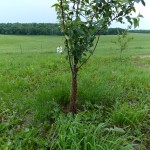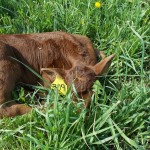
This is the second summer that our friends have brought their black cows to our farm for breeding. Their boys raise steers to show at the 4H fair. They have two black cows each with a black calf. The first summer they brought their cows to our farm their oldest son got out of the truck carrying a notebook. Before we could open the trailer door he double checked his notes to make sure he could identify his cows. He checked their ear tag information. He checked the calves ear tag information. He double checked the tag numbers. When he was certain he could identify his exact cows from our herd he said we could open the trailer door.
I smiled, “Have you seen our herd?”
“No, not yet.”
“Take a look in the field. I'm pretty sure you'll be able to figure out which cows are yours?”
He smiled and laughed, “ I guess I don't need my notebook, they'll be pretty easy to find.”
It was a very sweet moment. He'd been keeping accurate records for his 4H book and was concerned about identifying his cows and calves. Among our herd of Red Angus cattle his are very easy to find.












































